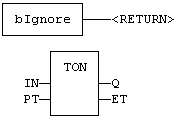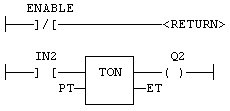
Statement - Jump to the end of the program.
The "RETURN" statement jumps to the end of the program. In FBD language, the return statement is represented by the "<RETURN>" symbol. The input of the symbol must be connected to a valid boolean signal. The jump is performed only if the input is TRUE. In LD language, the "<RETURN>" symbol is used as a coil at the end of a rung. The jump is performed only if the rung state is TRUE. In IL language, RET, RETC, RETCN and RETNC instructions are used.
When used within an action block of a SFC step, the RETURN statement jumps to the end of the action block.
IF NOT bEnable THEN
RETURN;
END_IF;
(* the rest of the program will not be executed
if bEnabled is FALSE *)
(* In this example the TON block will not be
called if bIgnore is TRUE *)

(* In this example the second rung will be
skipped if ENABLE is FALSE *)

Below is the meaning of possible
instructions:
RET
Jump to the end
always
RETC Jump to the end if the current result is
TRUE
RETNC
Jump to the end if the current result
is FALSE
RETCN Same as RETNC
Start: LD
IN1
RETC (* Jump to the end if IN1
is TRUE *)
LD IN2
(* these instructions are not executed *)
ST Q2
(* if IN1 is TRUE *)
RET (* Jump to the end
unconditionally *)
LD IN3
(* these instructions are never executed *)
ST Q3